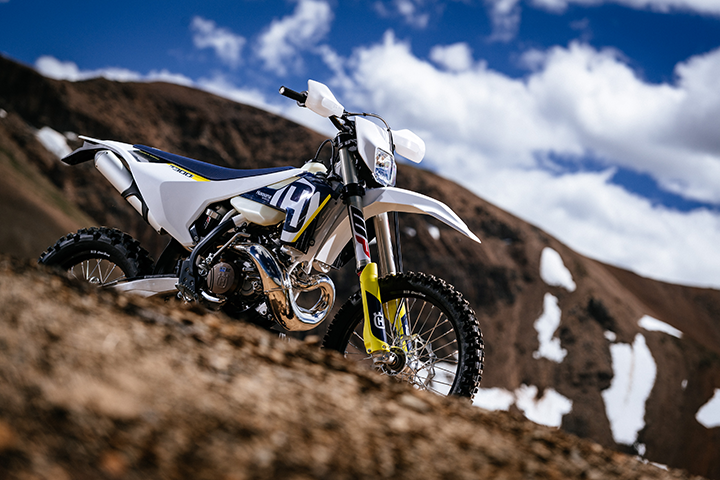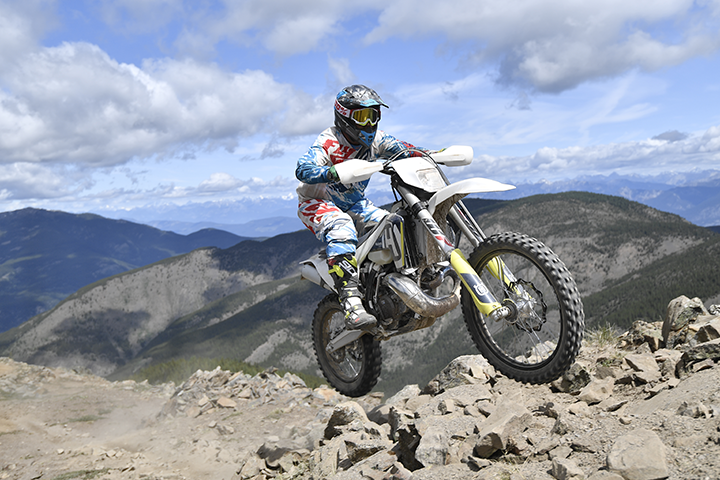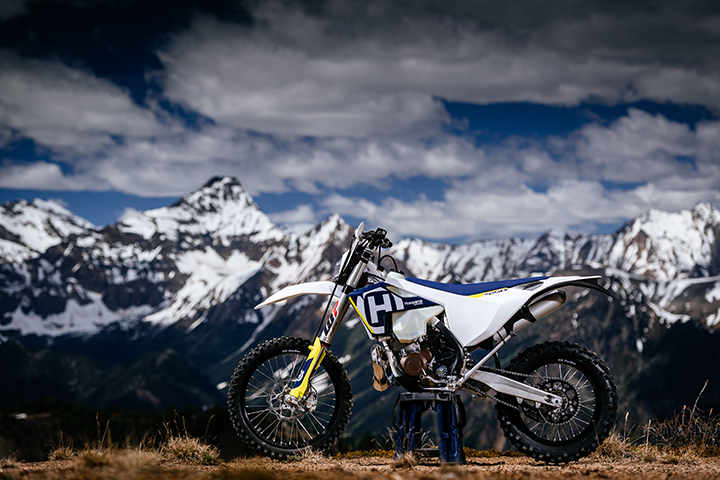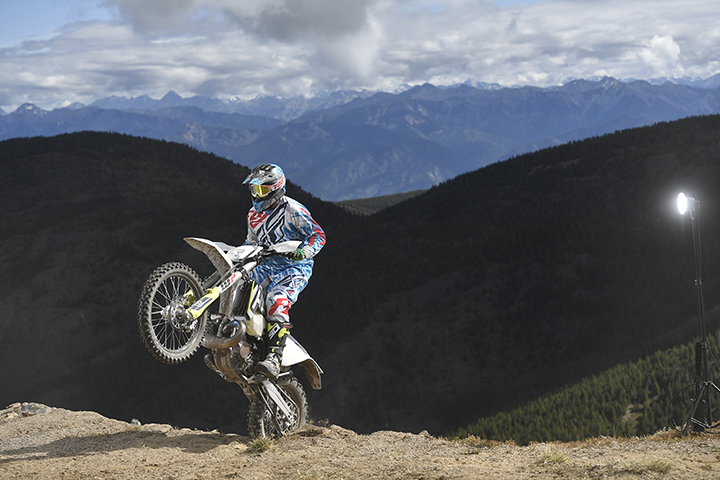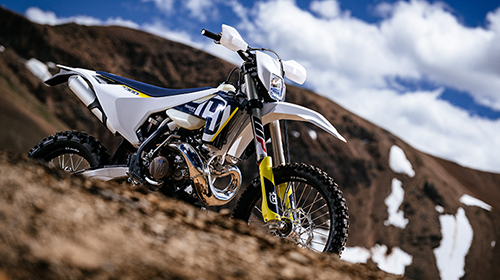
Goodbye premix, goodbye jetting. TPI is here. We head to Canada to ride the 2018 TE250I and TE300I
Story Damien Ashenhurst| Photography Husqvarna
As the morbidly obese woman rumbled down the Boeing 777’s isle, the hostess flanking her made eye contact with me and mouthed the words, “I’m so sorry…”
I had for the last few minutes entertained the chance that on this clearly full flight I had jagged an empty seat to my left. This wasn’t to be however and the giant woman approached, introducing herself in a Canadian drawl with the line nobody wants to hear prior to a 14 hour flight. “You’re gonna have to lift up the arm rest ‘cause can’t fit on one seat.” Then she sat on my left leg and insisted the reading light be on the entire flight because she doesn’t like the darkness and I was trapped. And with that I began the process of dissociating myself from my own body, much like death camp prisoner in order to escape the horror. To my right, Jon Hafey of Husqvarna Australia looked comfortable and would soon sleep like a baby. I wanted to punch him. We were on our way to the 2018 Husqvarna launch of the TE250i and TE300i in British Columbia, Canada.
“You’re gonna have to lift up the arm rest ‘cause can’t fit on one seat.” Then she sat on my left leg
BIG TRUCKS AND SKI LIFTS
That torturous flight brought us to Vancouver were I unfolded like a squeezed accordion and from there we hopped onto a flight for another couple of hours to Calgary. Calgary is the home of the Calgary Stampede (not sure what that is but it looked as though there was line-dancing involved), which was being set-up while we were there, along with celebrations for Canada Day which also happened to mark the country’s 150th year of confederation. Big things were happening. And everybody drives big cars. Silverados, Tundras, RAMs, F150s – it’s ute heaven, although they call them trucks. Six litre engines, dual axels, impossible to park but who cares. I want one. They’re cheap over there too which is sadly not the case once they arrive in Oz.
We happened to be staying at a hotel that housed the only pool with a licensed bar in the city and as it was summer at the time we got to meet many, many lovely people dressed in far less than what our friends were during winter back home. Nice people the Canadians.
From there we jumped into an opulent coach that looked like it had once transported Guns and Roses and headed three and a half hours west past Banff to the idyllic Panorama Mountain Resort. There are four ski resorts in the world that accommodate dirtbikes. Two are in Canada and this was one of them. So there we were in the unfamiliar surroundings of a ski lodges and chair lifts with 30 Husqvarnas lined up ready to roll. Oh and there are bears. You have to watch out for the bears.
So there we were in the unfamiliar surroundings of a ski lodges and chair lifts with 30 Husqvarnas lined up ready to roll
WHAT THE HELL IS TPI?
The type of fuel injection used by the 2018 Husqvarnas is Transfer Port Injection. This means there is no carburettor and instead a computer brain called an ECU controls all the facets that makes an engine function. Let’s start from the top, literally from the top of the bike up at the headstock which is where you’ll now find the oil filler cap. From here you pour in 700ml of oil (there is no special type of oil required beyond good two-stoke oil), and it travels down a feeder tube found inside the frame and gathers in a reservoir that’s mounted off the frame just behind and above the cylinder head. 700ml of oil is said to be good for at least five full tanks of fuel. That oil is fed via an electric pump at an average ratio of 80:1. That’s it for the oil. You do not pre-mix your fuel anymore and this bike will not appreciate it if you do. The oil and fuel does not meet until they are both inside the engine.
The oil is preceded by air introduced through the 39mm throttle body and both travel into the crank case and then up the transfer ports where they are met by one of the two injectors (one in each port) which again, controlled by the ECU, provides the fuel needed to complete the correct mix of air, oil and fuel in order to achieve combustion in the cylinder via that ever present wonder of the world, the spark plug. Whatever is remaining is expelled through the exhaust but this process produces far less waste and so the emissions are drastically reduced (claimed 50 per cent reduction in emissions). Another benefit from the increased efficiency is fuel usage which is claimed to be around 35 per cent less than a carby model.
It sounds simple enough and in fact the company researched three different methods before arriving at TPI as the most efficient and least complicated system. But there are a lot of decisions being made in fractions of a second while all this is going on and that’s why the development of the ECU was critical. For example via five separate sensors the brain must know and compensate for throttle position, temperature, humidity and elevation in real time and at all times. Any miscalculation will deliver a poor response to the rider.
Of course this system isn’t totally removed from what we have on four-strokes but it’s operating at higher revs which complicates things. But on the face of it we have two-strokes with electric start that no longer need premixed fuel and this has been the dream scenario for dinger riders through the ages. The wait is over.
WHAT ARE THEY LIKE TO RIDE?
The answer to this question comes with a caveat. Where we rode was nothing like conditions we’d find in Australian. We started at 1100 meters above sea level and made our way right up to 3000 metres which is 800 metres higher than the highest mountain in Oz. Beyond demonstrating how these two-strokes can handle huge elevation changes without the hassle of re-jetting, this made it tough to get a good gauge on the bikes which lost power in the thinner air so far up. The ride itself was basically going up and then going down and no real solid moto trails as we know them in between. So to be honest this wasn’t a good way to wholesale evaluate a bike for any of us but we’ll get into it regardless and go into more detail when they arrive in Australia early 2018.
The first thing I noticed was that on the cold start the two-stroke smell was still there and there was a small amount of exhaust smoke visible so the soul of the dinger clearly hadn’t been completely removed. The sound was familiar too so at this point it looks, smells and sounds like the two-stroke we all know.
Leaving the staging area the bike spluttered a little as a cold two-stroke does, but warmed and started to run right just as went headed into some single trail. The first proper stretch of track was super tight and winding with not much flow as it zig-zagged up the steep mountain. I started the day on the TE250I and I found early that it was brilliant at maintaining low revs where I’d expect a carby engine to bog or flame-out. The terrain was fairly loose but keeping traction was far easier than you’d expect. Using the ‘bar mounted mapping switch, I started in the traction mode but found that was a little too sedate and the more aggressive standard mapping was better for dealing with logs or ditches and the endless abrupt climbs.

As we ascended more and more and the air thinned out I found the 250 lacked a lot of punch and had a noticeable flat spot just short of half throttle. This isn’t entirely surprising given the altitudes but it felt as though the TPI had trouble keeping up with the rate of elevation change, something that was later confirmed by a Husqvarna engineer who told me that the system needs a little time adjust but the rate we were climbing or descending was too fast.
There was no doubt however that the bike had a fairly dramatic flat spot that appeared just before the bike could rev-up and bolt. There was a hesitation if you went from an open throttle then throttle-off and open up again. These bikes were in fact preproduction models and the engineers admitted that they were aware that the systems need further testing and refinement and this is clearly the case with the 250 which I expect will be greatly improved by the time the bikes arrive is Australia in 2018.
The 300 wasn’t a totally different story but it was a far easier and more exciting to ride with the extra mumbo and felt like it was a more complete and ready package than the 250. One thing I wondered about the EFI two-strokes was if they’d lose their punch and again, while this wasn’t the best place to test a bike I could feel on the 300 that it did still have that mongrel inside; maybe a little less of the aggressive hit that we’re used to but I suspect that the mountain was once again at play here. The 300 didn’t feel like it suffered from altitude sickness in the way the 250 did and maintained a healthy dose of aggression way up past where a carburettor bike would have spluttered and died.
The new Magura brakes where impressive. I’m a huge Brembo fan but didn’t like when KTM switched to softer pads and the Magura set-up reminds me of the feel the Brembos had a couple of years ago.
I’m also a fan of the new WP Xplor suspension. I know pro riders will bemoan its plushness in the early part of the stroke but I think this set-up will suit the broadest range of riders. I got it wrong with the 4CS fork which I categorized as best for the faster riders, until I rode a few more models and got to understand its failings, but I applaud WP for taking this direction. At the rear is the linkage shock which separates it from the PDS system on the KTM. I actually like both systems and inherently prefer a somewhat dead feeling in the rear (sounds like a rough week in prison), which you can get easily from the PDS but the linkage does hold its line into corners so well and again the Xlpor system is a clever compromise for those novice to intermediate riders – which is by far the majority.
One thing is clear; they haven’t gutted the two-stroke and given us some sort of two wheel toaster. The soul is still there
WHAT NOW?
Now we wait. The bikes don’t go into production until the end of the year and they will start arriving first thing in 2018. At this point we were told the 250 will be much improved with updated ECU settings and frankly we can’t wait to ride them in Australia. While the launch was kind of an odd one in terms of wholesale evaluating a bike, there was enough there to make us excited about the technology.
They will be more expensive but Husqvarna (and KTM) will also be bringing in carburettor models for 2018 so if you aren’t keen on change just yet you can still stick to what’s familiar.
Husqvarna admit that the system is more complicated than a carburettor but insist that the service times are pretty much the same and aside from the TPI itself, the engine is every bit the 250 and 300 we know so well.
There’s so much to like about what we see here and yet so many questions to ask which will have to wait until the bikes arrive in Australia and we can run them on home soil. One thing is clear; they haven’t gutted the two-stroke and given us some sort of two wheel toaster. The soul is still there. Remember these bikes also have the benefit of the balancing rod so they feel much more refined than any other and this new tech will march on and as we see with Yamaha’s 2018 YZ450F which can be tuned via a smartphone app, the electronics will get more and more user friendly and versatile. Bring it one we say. And get them to Oz – we have a nice trail prepped and ready for it.
HUSKY TIMES
- 130 years of motorcycle manufacturing
- Most successful year for Husqvarna for the fourth year in a row
- 2016 Husqvarna sales grew by 43 per cent
- Fastest growing manufacturer in the world
- Plan to sell 36,000 bikes in 2018 model year
- Hoping for another 20 per cent growth in 2018

